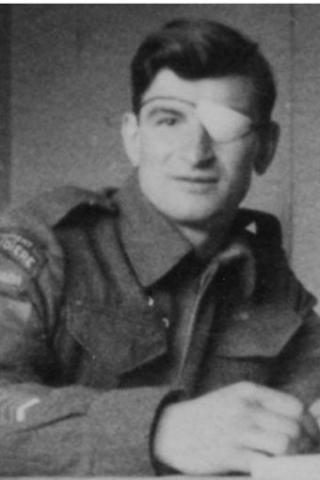
Joined
1940
Deployments
- Second World War
- Korean War
A hero in a foreign land
In the Dutch city of Zwolle, a Canadian flag waves in the breeze above a statue of a Canadian sniper who freed the city from its German occupiers at the end of the Second World War.
Léo Major’s bronze bust—in military uniform, rifle in hand—stands on a stone pedestal looking toward the city he single-handedly liberated under a waxing crescent moon one spring night eight decades ago.
Everyone in this town—an ocean away from his home—knows his name.

Léo Major banner at a soccer game in Zwolle.
“Léo Major was the first Canadian soldier I (a boy of 14) saw, on 14 April 1945, and with him came the freedom from five years of Nazi-dictatorship,” a Zwolle resident wrote in an online book of condolences after Major’s passing in October, 2008.
“I then of course didn’t know anything about him, but his appearance was the beginning of a new life for all of us.”
“I was 12 years old and he became my instant hero,” another Dutch man wrote.
Major was born in 1921 in New Bedford, Massachusetts, to French Canadian parents. The family moved to Montreal shortly after. He initially trained as a plumber before joining the army in 1940 at the age of 19. He trained in New Brunswick and England before landing in France on D-Day, 6 June 1944.
On the first day of the battle, he helped capture a German armoured vehicle. Days later, he had his first encounter with an SS patrol in Normandy. He defeated all of the soldiers, but not before one threw a phosphorus grenade at him, claiming his left eye.
Major was 87 when he died in Longueuil, Quebec, in a hospital bed surrounded by family, many of whom were still learning parts of the humble hero’s military past.
His story of bravery is the stuff of movies.
Some call him “the Rambo of Quebec.”
“The Rambo of Quebec” – a well-earned nick-name
The evening of 14 April 1945, Major was still recovering from a severe back injury after capturing 93 German soldiers and surviving a landmine explosion during the Battle of the Scheldt. By now, he had also adapted to wearing an eye patch on his damaged left eye. That night, he and his friend Corporal Wilfred (Welly) Arsenault set out toward Zwolle on a reconnaissance mission for the Allies’ planned attack the next morning.
The two Régiment de la Chaudière snipers were tasked with gauging the size of the German garrison and getting word to the Dutch resistance fighters.

Welly Arsenault (left) and Léo Major (right) c. 1944.
When Arsenault was killed by machine gun fire outside the town, an enraged and fearless Major spent the rest of the night avenging his death. He took Arsenault’s guns and ammunition and stormed into Zwolle—alone.
Major ran through the town firing his machine gun and throwing grenades. With the help of some underground resistance fighters he met, he took dozens of prisoners and set the Gestapo headquarters on fire.
When the Allies arrived at dawn, the Germans were gone and Zwolle’s 50,000 citizens—held hostage for nearly five years of Nazi occupation—were free.
As the “Sweetest Spring” began, daffodils and tulips bloomed along the banks of the rivers and canals and Canadian soldiers were celebrated in the streets.
A modest hero
In 2005, three years before he died, Major was made an honorary citizen of Zwolle. The liberation story is taught in schools and there are streets named in his honour in the Netherlands and also at home in Quebec. In 2020, on the 75th anniversary of the Netherlands’ liberation, the local soccer club put his name on their game jerseys.

Léo Major and his wife, Pauline, taken during their last visit to Zwolle in 2005 when Major was made an honorary citizen of the city.
Photo credit: Hans Smit – Zwolle in Beeld
Major’s children knew nothing of their father’s story until a Dutch official landed on their doorstep 30 years after the war ended. His son was nine years old when his father finally shared what happened that night in Zwolle.
He told his son how senior military leaders tried to send him home when his eye was injured but he refused.
“I’m a sniper. I only need one eye,’” Major’s son remembers his father saying.
Major was awarded the Distinguished Conduct Medal (DCM) for the liberation. He was given the prestigious award a second time for his bravery six years later, in 1951 when he led the capture of a key hill during the Korean War.
He is the only Canadian to receive a DCM in two wars.
When Major died on 12 October 2008, in Montreal, many Dutch dignitaries attended his funeral, including the Mayor of Zwolle. Zwolle named a street after him, made him an honorary citizen and holds an annual ceremony to remember his heroism.
The Léo Major Park in Quebec is named in his honour. He is buried at the Last Post Fund National Field of Honour in Pointe-Claire.
Interviews are from the documentary "Léo major : Le fantôme borgne“ © Les Films Sighter / www.sighter.com
With courage, integrity and loyalty, Léo Major has left his mark. Discover more stories.
The well-being of Canadian Veterans is at the heart of everything we do. As part of this, we recognize, honour and commemorate the service of all Canadian Veterans. Learn more about the services and benefits that we offer.